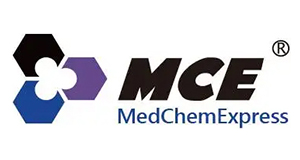Thiazole Orange, CAS 107091-89-4
Thiazole Orange, CAS 107091-89-4
SKU
MEXHY-D0150-1G
Packaging Unit
1 g
Manufacturer
MedChemExpress
Availability:
loading...
Price is loading...
Product Description: Thiazole Orange is an asymmetric anthocyanin dye that can be coupled with oligonucleotides (ONs) to prepare fluorescent hybridization probes. Thiazole Orange has been widely used in biomolecular detection and staining of DNA/ RNA in gels and can be used for reticulocyte analysis. Thiazole orange generates a significant fluorescence enhancement and high quantum yield when it binds with nucleic acids, especially RNA. Thiazole orange can permeate living cell membranes. Thiazole orange can use UV light for detection, but can also be detected with blue light. The excitation and emission of Thiazole orange are λex = 510 nm (488 nm and 470 nm also show strong excitation) and λem = 527 nm, respectively[1][2][3][4][5][6].
Formula: C26H24N2O3S2
References: [1]Linda G. Le, et al. Thiazole Orange: A New Dye for Reticulocyte Analysis. cytometry 7:508-517 (1986)/[2]Piotr Klimkowski, et al. Design of thiazole orange oligonucleotide probes for detection of DNA and RNA by fluorescence and duplex melting. Org Biomol Chem. 2019 Jun 28; 17(24): 5943–5950./[3]O'Neil CS, et al. DNA Electrophoresis Using Thiazole Orange Instead of Ethidium Bromide or Alternative Dyes. J Vis Exp. 2019 Mar 31;(145)/[4]Suss O, et al. Broad Applications of Thiazole Orange in Fluorescent Sensing of Biomolecules and Ions. Molecules. 2021 May 10;26(9):2828./[5]Long W, et al. Molecular Recognition and Imaging of Human Telomeric G-Quadruplex DNA in Live Cells: A Systematic Advancement of Thiazole Orange Scaffold To Enhance Binding Specificity and Inhibition of Gene Expression. J Med Chem. 2021 Feb 25;64(4):2125-2138./[6]Lu YJ, et al. Molecular Engineering of Thiazole Orange Dye: Change of Fluorescent Signaling from Universal to Specific upon Binding with Nucleic Acids in Bioassay. ACS Chem Biol. 2016 Apr 15;11(4):1019-29.
CAS Number: 107091-89-4
Molecular Weight: 476.61
Compound Purity: 99.61
Research Area: Others
Solubility: DMSO : 25 mg/mL (ultrasonic)/H2O : < 0.1 mg/mL/MEOH : 25 mg/mL (ultrasonic)
Target: Fluorescent Dye
Formula: C26H24N2O3S2
References: [1]Linda G. Le, et al. Thiazole Orange: A New Dye for Reticulocyte Analysis. cytometry 7:508-517 (1986)/[2]Piotr Klimkowski, et al. Design of thiazole orange oligonucleotide probes for detection of DNA and RNA by fluorescence and duplex melting. Org Biomol Chem. 2019 Jun 28; 17(24): 5943–5950./[3]O'Neil CS, et al. DNA Electrophoresis Using Thiazole Orange Instead of Ethidium Bromide or Alternative Dyes. J Vis Exp. 2019 Mar 31;(145)/[4]Suss O, et al. Broad Applications of Thiazole Orange in Fluorescent Sensing of Biomolecules and Ions. Molecules. 2021 May 10;26(9):2828./[5]Long W, et al. Molecular Recognition and Imaging of Human Telomeric G-Quadruplex DNA in Live Cells: A Systematic Advancement of Thiazole Orange Scaffold To Enhance Binding Specificity and Inhibition of Gene Expression. J Med Chem. 2021 Feb 25;64(4):2125-2138./[6]Lu YJ, et al. Molecular Engineering of Thiazole Orange Dye: Change of Fluorescent Signaling from Universal to Specific upon Binding with Nucleic Acids in Bioassay. ACS Chem Biol. 2016 Apr 15;11(4):1019-29.
CAS Number: 107091-89-4
Molecular Weight: 476.61
Compound Purity: 99.61
Research Area: Others
Solubility: DMSO : 25 mg/mL (ultrasonic)/H2O : < 0.1 mg/mL/MEOH : 25 mg/mL (ultrasonic)
Target: Fluorescent Dye
| SKU | MEXHY-D0150-1G |
|---|---|
| Manufacturer | MedChemExpress |
| Manufacturer SKU | HY-D0150-1G |
| Package Unit | 1 g |
| Quantity Unit | STK |
| Product information (PDF) |
|
| MSDS (PDF) |
|

 Deutsch
Deutsch








